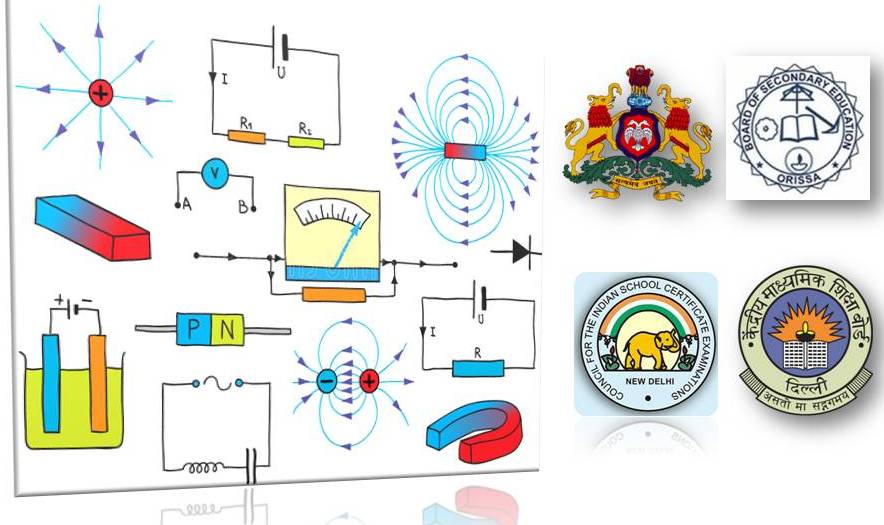Physics preparatory tests for PUC, ISc, class XII in the CBSE, ICSE (CISCE), State boards.
Subject: Physics
Test: Preparatory test — II. Pre-Quarterly.
Class: PUC — II (also good for ISC — II)
date: 25 the June 2013.
Time: 1.5 hours.
Total marks: 50
Instructions.— Numerical problems solved without writing the relevant formulas carry no marks.— Answers without relevant diagrams, circuits wherever necessary will not carry any marks.
PART-A
I. Answer all the following questions (1 X 5)
Question 1
Where would Coulomb’s interaction be weaker, in dielectric medium or vacuum?
Question 2
Between a dipole and a point charge whose electric potential reduces faster?
Question 3
What is the work done when a charge makes a rectangular path on an equipotential surface?
Question 4
Write the de-Broglie formula for wavelength of a wave-particle if its momentum is p?
Question 5
Define refractive index from angle of incidence and angle of reflection.
PART-B
II. Answer any Five of the following questions, 2 marks each. (2 X 5=10)
Question 6
State how density of electric lines of force is related to the electric field vector intensity E. Also mention another property of the lines of force and one property of the equipotential surface.
Question 7
Write the Gauss law of electrostatics and define electric flux for a uniform field E.
Question 8
How one defines the direction of a dipole vector? What’s the potential vertical to the dipole axis?
Question 9
What’s the energy of an electron if we place it in a potential difference of 100 volt assuming its at rest at this location? What will be the energy of an if its placed at the same location at rest.
Question 10
Define atomic number and atomic mass unit.
Question 11
Write out the expression of level atomic spectra (energy level) of a Hydrogen atom. What energy will be released if the electron jumps from level 5 to level 3?
Question 12
Write out the mirror equation. If an image is at and object at
what’s the focal length of the mirror?
Question 13
If angle of incidence is and angle of refraction is
what will be the refractive index of the medium?
PART-C
III. Answer any one of the following questions (5 X 1)
Question 14
Derive the electric field vector for the dipole vector P in a direction of alignment with the dipole vector, also called the End-On configuration.
Question 15
Derive the scalar potential in a general direction at angle
to the dipole.
IV. Answer any two of the following questions (5 X 2)
Question 16
Define electric flux in 1 or 2 lines and write out expression for it for a uniform and non-uniform electric field E. State Gauss law in terms of charge and flux in differential and integral form. State the vector form of Coulomb’s law of electrostatics force. What’s the flux of a vector if it is aligned to the area vector?
Question 17
Define lines of force and flux of a vector. State Gauss law and derive its mathematical form by considering spherical symmetry.
Question 18
Obtain an expression for the nuclear size of an atom by solving for distance of closest approach . Use an incoming
of mass
and charge
that’s deflected by the presence of a nucleus of atomic number
to obtain
. Now replace the variables by some numerical values:
,
,
, and
. Express the answer in femto-meters.
V. Answer any three of the following questions (5 X 3)
Question 19
A proton has a radius R and the charge Q is uniformly distributed. Use Bohr’s atomic energy level formula for the 1st excited state (n = 2) and ground state (n = 1) to obtain energy of the Hydrogen-atom.
Question 20
State the power of a lens and thin lens formula. For thin lens case determine the focal length if the object distance is and image distance is
.
Question 21
Draw a simple and neat diagram showing a convex lens, optical center and focal point (focus). Now define power of a lens and obtain an expression for it.
Question 22
Write the expression for the electrostatics potential of a point charge. Calculate the potential for a nitrogen nucleus at a distance of 1 femto-meter (fm) — .
. Also do this for N = 10.
VI. Answer the following question (5 X 1)
Question 23
Following readings were obtained in one experiment you have performed to determine the focal length of a convex lens by u-v method. Fill the data in the table for u, v, x, y and plot the graph between x and y and obtain the slope S. Then determine the focal length from the slope.
| SN | Object O (cm) | Lens L (cm) | Image I (cm) | u (cm) | v (cm) | ||
| 1 | 1.0 | 29.0 | 45.5 | ||||
| 2 | 6.0 | 29.0 | 48.5 | ||||
| 3 | 11.0 | 29.0 | 59.0 | ||||
| 4 | 16.0 | 35.0 | 59.0 | ||||
| 5 | 21.0 | 40.0 | 64.0 |
Determine s = slope, and focal length:
.

Leave a comment